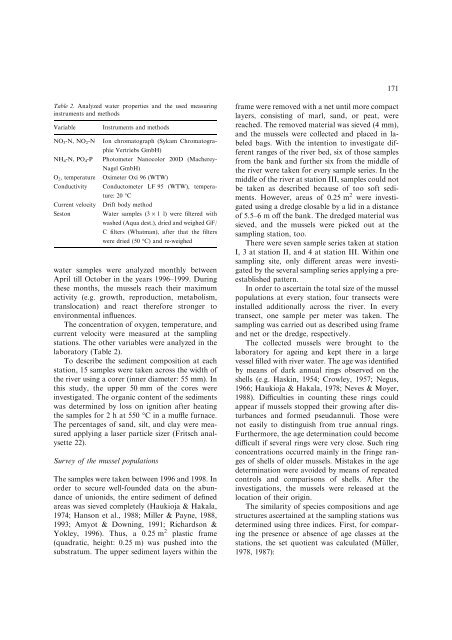Population size and structure of three mussel species (Bivalvia ...
Population size and structure of three mussel species (Bivalvia ...
Population size and structure of three mussel species (Bivalvia ...
You also want an ePaper? Increase the reach of your titles
YUMPU automatically turns print PDFs into web optimized ePapers that Google loves.
171<br />
Table 2. Analyzed water properties <strong>and</strong> the used measuring<br />
instruments <strong>and</strong> methods<br />
Variable<br />
NO 3 -N, NO 2 -N<br />
NH 4 -N, PO 4 -P<br />
O 2 , temperature<br />
Conductivity<br />
Current velocity<br />
Seston<br />
Instruments <strong>and</strong> methods<br />
Ion chromatograph (Sykam Chromatographie<br />
Vertriebs GmbH)<br />
Photometer Nanocolor 200D (Macherey-<br />
Nagel GmbH)<br />
Oximeter Oxi 96 (WTW)<br />
Conductometer LF 95 (WTW), temperature:<br />
20 °C<br />
Drift body method<br />
Water samples (3 · 1 l) were filtered with<br />
washed (Aqua dest.), dried <strong>and</strong> weighed GF/<br />
C filters (Whatman), after that the filters<br />
were dried (50 °C) <strong>and</strong> re-weighed<br />
water samples were analyzed monthly between<br />
April till October in the years 1996–1999. During<br />
these months, the <strong>mussel</strong>s reach their maximum<br />
activity (e.g. growth, reproduction, metabolism,<br />
translocation) <strong>and</strong> react therefore stronger to<br />
environmental influences.<br />
The concentration <strong>of</strong> oxygen, temperature, <strong>and</strong><br />
current velocity were measured at the sampling<br />
stations. The other variables were analyzed in the<br />
laboratory (Table 2).<br />
To describe the sediment composition at each<br />
station, 15 samples were taken across the width <strong>of</strong><br />
the river using a corer (inner diameter: 55 mm). In<br />
this study, the upper 50 mm <strong>of</strong> the cores were<br />
investigated. The organic content <strong>of</strong> the sediments<br />
was determined by loss on ignition after heating<br />
the samples for 2 h at 550 °C in a muffle furnace.<br />
The percentages <strong>of</strong> s<strong>and</strong>, silt, <strong>and</strong> clay were measured<br />
applying a laser particle <strong>size</strong>r (Fritsch analysette<br />
22).<br />
Survey <strong>of</strong> the <strong>mussel</strong> populations<br />
The samples were taken between 1996 <strong>and</strong> 1998. In<br />
order to secure well-founded data on the abundance<br />
<strong>of</strong> unionids, the entire sediment <strong>of</strong> defined<br />
areas was sieved completely (Haukioja & Hakala,<br />
1974; Hanson et al., 1988; Miller & Payne, 1988,<br />
1993; Amyot & Downing, 1991; Richardson &<br />
Yokley, 1996). Thus, a 0.25 m 2 plastic frame<br />
(quadratic, height: 0.25 m) was pushed into the<br />
substratum. The upper sediment layers within the<br />
frame were removed with a net until more compact<br />
layers, consisting <strong>of</strong> marl, s<strong>and</strong>, or peat, were<br />
reached. The removed material was sieved (4 mm),<br />
<strong>and</strong> the <strong>mussel</strong>s were collected <strong>and</strong> placed in labeled<br />
bags. With the intention to investigate different<br />
ranges <strong>of</strong> the river bed, six <strong>of</strong> those samples<br />
from the bank <strong>and</strong> further six from the middle <strong>of</strong><br />
the river were taken for every sample series. In the<br />
middle <strong>of</strong> the river at station III, samples could not<br />
be taken as described because <strong>of</strong> too s<strong>of</strong>t sediments.<br />
However, areas <strong>of</strong> 0.25 m 2 were investigated<br />
using a dredge closable by a lid in a distance<br />
<strong>of</strong> 5.5–6 m <strong>of</strong>f the bank. The dredged material was<br />
sieved, <strong>and</strong> the <strong>mussel</strong>s were picked out at the<br />
sampling station, too.<br />
There were seven sample series taken at station<br />
I, 3 at station II, <strong>and</strong> 4 at station III. Within one<br />
sampling site, only different areas were investigated<br />
by the several sampling series applying a preestablished<br />
pattern.<br />
In order to ascertain the total <strong>size</strong> <strong>of</strong> the <strong>mussel</strong><br />
populations at every station, four transects were<br />
installed additionally across the river. In every<br />
transect, one sample per meter was taken. The<br />
sampling was carried out as described using frame<br />
<strong>and</strong> net or the dredge, respectively.<br />
The collected <strong>mussel</strong>s were brought to the<br />
laboratory for ageing <strong>and</strong> kept there in a large<br />
vessel filled with river water. The age was identified<br />
by means <strong>of</strong> dark annual rings observed on the<br />
shells (e.g. Haskin, 1954; Crowley, 1957; Negus,<br />
1966; Haukioja & Hakala, 1978; Neves & Moyer,<br />
1988). Difficulties in counting these rings could<br />
appear if <strong>mussel</strong>s stopped their growing after disturbances<br />
<strong>and</strong> formed pseudannuli. Those were<br />
not easily to distinguish from true annual rings.<br />
Furthermore, the age determination could become<br />
difficult if several rings were very close. Such ring<br />
concentrations occurred mainly in the fringe ranges<br />
<strong>of</strong> shells <strong>of</strong> older <strong>mussel</strong>s. Mistakes in the age<br />
determination were avoided by means <strong>of</strong> repeated<br />
controls <strong>and</strong> comparisons <strong>of</strong> shells. After the<br />
investigations, the <strong>mussel</strong>s were released at the<br />
location <strong>of</strong> their origin.<br />
The similarity <strong>of</strong> <strong>species</strong> compositions <strong>and</strong> age<br />
<strong>structure</strong>s ascertained at the sampling stations was<br />
determined using <strong>three</strong> indices. First, for comparing<br />
the presence or absence <strong>of</strong> age classes at the<br />
stations, the set quotient was calculated (Mu¨ ller,<br />
1978, 1987):
















